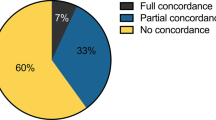Abstract
Postoperative fever following endoscopic endonasal surgery is a rare occurrence of concern to surgeons. To elucidate preoperative and operative predictors of postoperative fever, we analyzed the characteristics of patients and their perioperative background in association with postoperative fever. A retrospective review of 371 patients who had undergone endoscopic endonasal surgery was conducted. Predictors, including intake of antibiotics, steroids, history of asthma, preoperative nasal bacterial culture, duration of operation, duration of packing and intraoperative intravenous antibiotics on the occurrence of postoperative fever, and bacterial colonization on the packing material, were analyzed retrospectively. Fever (≥38 °C) occurred in 63 (17 %) patients. Most incidences of fever occurred on postoperative day one. In majority of these cases, the fever subsided after removal of the packing material without further antibiotic administration. However, one patient who experienced persistent fever after the removal of packing material developed meningitis. History of asthma, prolonged operation time (≥108 min), and intravenous cefazolin administration instead of cefmetazole were associated with postoperative fever. Odds ratios (ORs) for each were 2.3, 4.6, and 2.0, respectively. Positive preoperative bacterial colonization was associated with postoperative bacterial colonization on the packing material (OR 2.3). Postoperative fever subsided in most patients after removal of the packing material. When this postoperative fever persists, its underlying cause should be examined.




Similar content being viewed by others
References
Fisher BW, Majumdar SR, McAlister FA (2002) Predicting pulmonary complications after nonthoracic surgery: a systematic review of blinded studies. Am J Med 112:219–225
Jacobson JA, Kasworm EM (1986) Toxic shock syndrome after nasal surgery. Case reports and analysis of risk factors. Arch Otolaryngol Head Neck Surg 112:329–332
Abram AC, Bellian KT, Giles WJ, Gross CW (1994) Toxic shock syndrome after functional endonasal sinus surgery: an all or none phenomenon? Laryngoscope 104:927–931
Bratzler DW, Dellinger EP, Olsen KM et al (2013) Clinical practice guidelines for antimicrobial prophylaxis in surgery. Am J Health Syst Pharm 70:195–283
Rechtweg JS, Paolini RV, Belmont MJ, Wax MK (2001) Postoperative antibiotic use of septoplasty: a survey of practice habits of the membership of the American Rhinologic Society. Am J Rhinol 15:315–320
Okushi T, Yoshikawa M, Otori N et al (2012) Evaluation of symptoms and QOL with calcium alginate versus chitin-coated gauze for middle meatus packing after endoscopic sinus surgery. Auris Nasus Larynx 39:31–37
Silk KL, Ali MB, Cohen BJ et al (1991) Absence of bacteremia during nasal septoplasty. Arch Otolaryngol Head Neck Surg 117:54–55
Rontal M, Bernstein JM, Rontal E, Anon J (1999) Bacteriologic findings from the nose, ethmoid, and bloodstream during endoscopic surgery for chronic rhinosinusitis: implications for antibiotic therapy. Am J Rhinol 13:91–96
Mitchell CK, Smoger SH, Pfeifer MP et al (1998) Multivariate analysis of factors associated with postoperative pulmonary complications following general elective surgery. Arch Surg 133:194–198
Engoren M (1995) Lack of association between atelectasis and fever. Chest 107:81–84
Mavros MN, Velmahos GC, Falagas ME (2011) Atelectasis as a cause of postoperative fever: where is the clinical evidence? Chest 140:418–424
Chung F, Mezei G, Tong D (1999) Pre-existing medical conditions as predictors of adverse events in day-case surgery. Br J Anaesth 83:262–270
Meltzer EO, Charous BL, Busse WW, Zinreich SJ, Lorber RR, Danzig MR (2000) Added relief in the treatment of acute recurrent sinusitis with adjunctive mometasone furoate nasal spray. The Nasonex Sinusitis Group. J Allergy Clin Immunol 106:630–637
Gotfried MH (2004) Macrolides for the treatment of chronic sinusitis, asthma, and COPD. Chest 125:52S–60S
Warner DO, Warner MA, Barnes RD et al (1996) Perioperative respiratory complications in patients with asthma. Anesthesiology 85:460–467
Pearlman AN, Chandra RK, Chang D et al (2009) Relationships between severity of chronic rhinosinusitis and nasal polyposis, asthma, and atopy. Am J Rhinol Allergy 23:145–148
Roy S, Wilkins J, Galaif E, Azen C (1989) Comparative efficacy and safety of cefmetazole or cefoxitin in the prevention of postoperative infection following vaginal and abdominal hysterectomy. J Antimicrob Chemother 23 Suppl D:109–117
Mangram AJ, Horan TC, Pearson ML, Silver LC, Jarvis WR (1999) Guideline for Prevention of Surgical Site Infection, 1999. Centers for Disease Control and Prevention (CDC) Hospital Infection Control Practices Advisory Committee. Am J Infect Control 27:97–134
Bratzler DW, Houck PM, Surgical Infection Prevention Guidelines Writers Workgroup et al (2004) Antimicrobial prophylaxis for surgery: an advisory statement from the National Surgical Infection Prevention Project. Clin Infect Dis 38:1706–1715
Jones RN (1989) Review of the in vitro spectrum and characteristics of cefmetazole (CS-1170). J Antimicrob Chemother 23:1–12
Brook I (2002) Anaerobic bacteria in upper respiratory tract and other head and neck infections. Ann Otol Rhinol Laryngol 111:430–440
Author information
Authors and Affiliations
Corresponding author
Ethics declarations
Conflict of interest
The authors declare no conflict of interest.
Additional information
This study was approved by the institutional review board of Jichi Medical University.
Rights and permissions
About this article
Cite this article
Nomura, K., Yamanaka, Y., Sekine, Y. et al. Predicting postoperative fever and bacterial colonization on packing material following endoscopic endonasal surgery. Eur Arch Otorhinolaryngol 274, 167–173 (2017). https://doi.org/10.1007/s00405-016-4189-9
Received:
Accepted:
Published:
Issue Date:
DOI: https://doi.org/10.1007/s00405-016-4189-9




